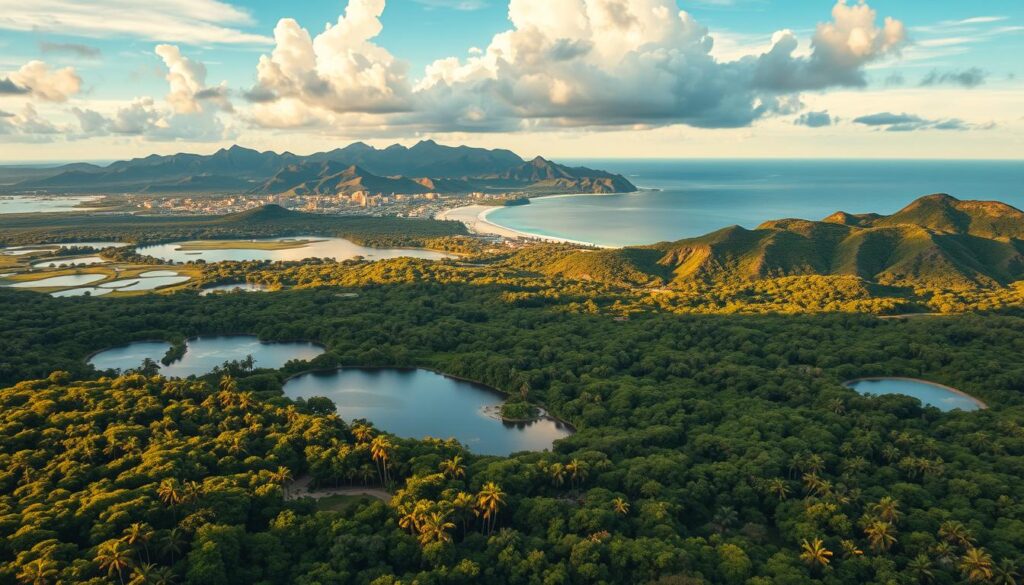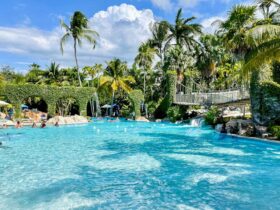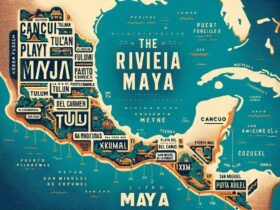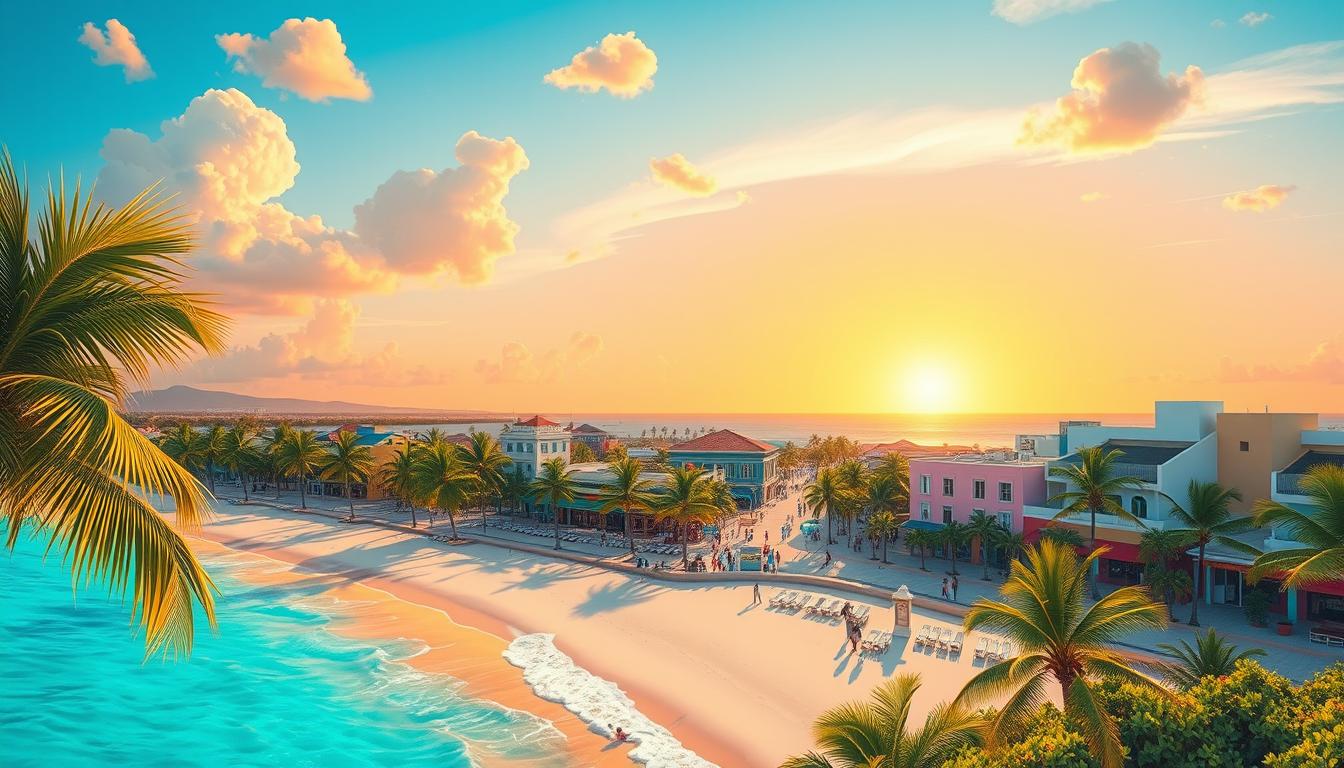Welcome to our comprehensive guide on the best time to visit Playa del Carmen! Whether you’re planning a quick getaway or an extended stay, understanding the local weather trends is key to making your trip enjoyable and stress-free.
Today’s forecast shows partly cloudy skies with temperatures of 30°/22° and wind from SE at 15-30 km/h. These conditions are ideal for exploring the city’s vibrant streets and stunning beaches. We’re passionate about sharing local insights and up-to-date weather observations to help you make informed decisions.
Throughout this guide, we’ll break down the seasons, highlight key events like the Festival of Virgin of Carmen, and provide tips on avoiding crowds and making the most of your visit. Our expertise in local climate analytics ensures you’re well-prepared for your adventure.
Key Takeaways
- Plan your visit during the dry season (December to April) for optimal conditions.
- November is ideal for fewer crowds and events like Día de Muertos.
- Summer months offer whale shark snorkeling but come with higher humidity.
- September is the rainiest month, but prices are lower.
- Spring Break in March attracts large crowds and higher prices.
Overview of Playa del Carmen Weather Trends
Playa del Carmen’s climate is characterized by a mix of mostly cloudy skies and stable humidity levels throughout the year. These conditions create a unique environment that appeals to both residents and visitors.
Understanding leveluv data and index0 values is crucial for predicting weather patterns. These metrics help us track changes in cloud cover and humidity, which are essential for planning daily activities and trips.
The interplay of these factors defines the local climate, making it important to stay informed about current weather observations and trends. By doing so, we can better appreciate the seasonal variations and make the most of our time here.
Monthly Weather Breakdown
Understanding the monthly weather patterns is essential for planning your visit. Each month brings unique conditions, shaping the ideal time to explore this vibrant destination.
Highs, Lows, and Rainfall Patterns
Temperatures range from 22°C to 31°C throughout the year. The dry season (December to April) offers mild highs around 28°C, ideal for outdoor activities. Rainfall is minimal, averaging 24mm in March, making it perfect for sunny days.
Seasonal Variations Across the Year
The wet season (May to October) brings higher humidity and rainfall, peaking in September with 237mm. Despite the rain, summer months like July and August are great for swimming, with sea temperatures around 29°C.
Data Insights from Local Observations
Local data shows that cloudy skies are common, especially in January. The leveluv index7 and leveluv index8 ratings indicate moderate to high UV levels, essential for sun protection.
“The interplay of cloud cover and UV levels creates a unique microclimate, making each month distinct.” – Local Meteorologist
| Month | Avg. High (°C) | Avg. Rainfall (mm) |
|---|---|---|
| January | 28.3 | 77 |
| July | 32.5 | 121 |
| September | 31.9 | 237 |
Comprehensive Playa del Carmen Weather Analysis
Understanding the intricacies of the local climate is essential for making the most of your trip. We delve into the key metrics that shape the weather patterns here, helping you plan your activities with confidence.
Key Metrics: Temperature, Humidity, and UV
Temperature and humidity are crucial factors in determining the comfort level during your stay. Average temperatures range from 23°C to 31°C throughout the year, with humidity levels typically staying between 60-80%. The UV index, particularly the index7 rating, is a significant indicator of sun exposure, emphasizing the need for proper protection.
Interpreting Cloud Cover: Partly and Mostly Cloudy
Cloud cover plays a vital role in the daily weather experience. Partly cloudy skies often prevail, especially on Saturdays, creating ideal conditions for outdoor activities. In contrast, mostly cloudy days can bring occasional rain showers, though they still offer pleasant temperatures.
- Temperature: 23°C – 31°C
- Humidity: 60-80%
- UV Index: 6-8 (moderate to high)
“Understanding these metrics helps travelers make informed decisions and enjoy their time here to the fullest.”
By analyzing these elements, you can better prepare for your trip, ensuring a memorable experience regardless of the season.
Seasonal Comparison and Trends
When planning your trip, understanding the seasonal trends and how they impact your experience is crucial. By analyzing key metrics like index8 values and leveluv index6 data, we can better understand the solar impacts and make informed decisions.
Peak Tourist vs. Off-Peak Periods
Peak tourist seasons, like December to April, offer mild conditions perfect for outdoor activities, but they come with larger crowds and higher prices. In contrast, the off-peak periods, such as May to October, provide a quieter experience with lower costs, though they may bring more rainfall.
- Peak seasons offer ideal monday forecasts for planning.
- Off-peak periods allow for a more relaxed atmosphere.
Choosing the Best Month for Your Trip
Your preferences will guide the best month to visit. If you prefer sunny days, consider the dry season. For a quieter experience, the off-peak months might be more suitable. Always check the index8 measurements and leveluv index6 figures to plan accordingly.
- Consider monday trends for accurate planning.
- Use index8 data to avoid rainy days.
By understanding these trends and metrics, you can make the most of your trip, ensuring a memorable experience tailored to your preferences.
For more insights on local resorts and accommodations, visit our resorts review page.
Sunrise, Sunset, and Twilight Explained
Understanding the daily cycles of daylight in Quintana Roo can greatly enhance your travel experience. From the first light of dawn to the last hues of dusk, each phase offers unique opportunities for exploration and relaxation.
Civil Twilight and Its Impact on Activities
Civil twilight, lasting about 22 minutes in the morning and evening, is when the sun is just below the horizon. This period is ideal for early risers and those who enjoy outdoor activities like jogging or photography. The soft light during civil twilight in Quintana Roo creates perfect conditions for capturing stunning images or simply enjoying a peaceful start to your day.
Astronomical Twilight and Nighttime Visibility
Astronomical twilight, which lasts around 25 minutes, marks the transition to nighttime. This period is excellent for stargazing and evening events. The darker skies during astronomical twilight offer clearer views of the stars, making it a favorite time for astronomy enthusiasts visiting Carmen.
By understanding these twilight phases, you can plan your activities more effectively, whether it’s an early morning hike or a late evening stroll along the beach. The interplay of light and darkness in Quintana Roo adds a magical touch to your travel experiences.

Impact of Humidity and UV Levels
Humidity and UV levels are two critical factors that shape your experience in Quintana Roo. Understanding these elements helps you prepare better and enjoy your trip to the fullest.
Understanding UV Index Variations
The UV Index in Quintana Roo can reach up to 10, which is very high. This means sun protection is essential, especially during peak hours. UV Index variations affect not just skin safety but also how you plan your day. For instance, a high UV Index during the day may mean you need more frequent sunscreen applications and protective gear.
Managing High Humidity Conditions
High humidity in Quintana Roo can make the air feel warmer. To manage this, stay hydrated, wear breathable clothing, and plan outdoor activities for cooler parts of the day. Using day sat night metrics, you can track how humidity and temperature change, helping you decide the best times to explore.
By considering both UV Index and humidity, you can create a comfortable and enjoyable itinerary. Whether you’re exploring during the day or relaxing at night, understanding these factors ensures a memorable trip to Quintana Roo.
Cloud Cover and Skies: Partly Cloudy vs. Cloudy
Understanding the nuances of cloud cover is essential for making the most of your trip. Whether it’s partly cloudy or fully overcast, knowing what to expect helps you plan your days effectively.
Decoding Weather Descriptions
Partly cloudy skies mean the sun is still visible, offering a balance of shade and sunlight. This is ideal for outdoor activities like beach visits or exploring. On the other hand, fully overcast days bring more consistent shade and often higher humidity, which can be more comfortable for some travelers.
Local forecasts frequently mention “sat day sat” patterns, which indicate periods of partly cloudy conditions. These are perfect for photography, as the soft light enhances colors and reduces harsh shadows.
What to Expect on Overcast Days
Overcast days can still be enjoyable. Morning walks or bike rides are great in these conditions, as the cooler temperatures make for a pleasant experience. Additionally, the “day crescentmoon” phase at night offers clearer stargazing, a unique treat for astronomy enthusiasts.
The “leveluv index10” measurements are crucial on partly cloudy days, reminding us to protect ourselves from the sun even when it’s not fully out. This is especially important during peak hours to prevent sunburn.
For overcast days, consider indoor activities like visiting museums or spas. If you’re outdoors, breathable clothing and hydration are key to staying comfortable in the humidity.
| Cloud Cover Type | UV Index Levels | Recommended Activities |
|---|---|---|
| Partly Cloudy | High (leveluv index10) | Outdoor activities with sun protection |
| Overcast | Lower | Indoor activities or shaded outdoor exploring |
By understanding these conditions, you can tailor your itinerary to match the sky’s mood, ensuring a memorable and enjoyable trip.
Wind Patterns and Their Effects on Travel
Wind patterns play a significant role in shaping your travel experience, influencing everything from outdoor activities to water sports. Understanding wind directions and speeds can help you plan your trip more effectively and ensure a smooth journey.
Wind Directions and Speeds Explained
Winds in this region typically come from the southeast (SE) and east (E), with speeds ranging from 10 to 30 km/h. These moderate breezes can significantly impact your travel comfort and safety, especially during water activities like snorkeling or boating.
The humidity levels often rise with SE winds, creating a more comfortable environment for outdoor exploration. However, stronger winds from the NE can bring cooler temperatures, which might be refreshing but could also affect certain activities.
During a day gibbousmoon, the wind patterns tend to shift slightly, leading to clearer skies and calmer conditions. This makes it an ideal time for activities like kiteboarding or simply enjoying a peaceful day at the beach.
Our mon mon day observations highlight how wind conditions can change rapidly. For instance, a gentle breeze in the morning might turn into stronger gusts by evening. Staying informed about these changes is crucial for planning your daily itinerary.
By understanding and adapting to wind patterns, you can make the most of your travel experience. Whether it’s choosing the best days for outdoor adventures or preparing for potential changes in the weather, being wind-wise ensures a memorable and enjoyable trip.
Planning Your Trip: Best and Worst Months
When planning your trip, understanding the best and worst months to visit is crucial for an enjoyable experience. By analyzing specific weather snapshots, such as wind direction and rainfall percentages, we can identify optimal travel periods.
Advantages of Visiting During Favorable Weather
Visiting during favorable weather offers a more comfortable and enjoyable experience. For instance, the dry season from December to April provides mild conditions, ideal for outdoor activities like exploring vibrant streets and beaches. Additionally, the dry season sees minimal rainfall, averaging just 24mm in March, making it perfect for sunny days. These conditions are enhanced by moderate humidity levels and UV Index variations, which are essential for planning daily activities and trips.
Months to Approach with Caution
Certain months require caution due to less favorable conditions. The wet season, particularly September, brings higher humidity and significant rainfall, averaging 237mm. Despite the rain, summer months like July and August are great for swimming, with sea temperatures around 29°C. Understanding wind ene patterns and day thu night temperature variations helps identify ideal times for activities, ensuring a comfortable and enjoyable stay.
| Month | Best/Worst | Key Metrics |
|---|---|---|
| May | Best | Low humidity, moderate UV levels |
| August | Best | Warm sea temperatures, sunny days |
| September | Worst | High rainfall, increased humidity |
| October | Worst | Peak hurricane risk, higher prices |
By considering these factors, you can make informed decisions to maximize your experience while minimizing potential hassles. Remember to check real-time weather updates for the most accurate planning.
Local Insights from Quintana Roo Weather Data
Exploring Quintana Roo’s unique weather patterns reveals fascinating insights for travelers. Detailed local data shows that even within this region, microclimates create notable variations in temperature and humidity over short distances.
Regional Variability and Microclimates
Microclimates play a significant role in shaping day-to-day conditions. For instance, coastal areas may experience cooler breezes, while inland regions can feel warmer due to less wind. These variations mean that conditions can change dramatically within just a few miles.
- We highlight unique local insights from Quintana Roo’s weather data.
- Microclimates cause noticeable variations in temperature and humidity within short distances.
- Mon day mon patterns are crucial for understanding weekly weather trends.
- Wed day wed observations provide insights into midweek conditions.
- Day sat trends are essential for planning weekend excursions.
By considering these patterns, travelers can make informed decisions. For example, a day sat trend might indicate ideal conditions for outdoor activities, while mon day mon patterns could suggest planning around potential humidity spikes.

Tips for Enjoying Playa del Carmen in Different Conditions
Planning your trip to Playa del Carmen? Understanding the local conditions is key to making the most of your visit. Whether you’re here during a sat day or experiencing the gentle winds ese, being prepared ensures a memorable experience.
Packing Essentials Based on Weather Trends
Your packing list should reflect the expected conditions. For a sat sat day, lightweight, breathable clothing is ideal. Don’t forget a hat and sunscreen for outdoor adventures.
Evenings can be cooler, especially in the dry season, so pack a light jacket. If visiting during the wet season, include a compact umbrella and waterproof accessories.
| Condition | Recommended Clothing | Activities |
|---|---|---|
| Sunny Days | Lightweight fabrics, hats, sunscreen | Beach relaxation, snorkeling |
| Windy Days | Light jacket, secure hats | Kiteboarding, beach walks |
| Overcast Nights | Comfortable sweaters | Dining out, evening strolls |
- Check forecasts for winds ese to plan water activities.
- Layer clothing for fluctuating temperatures on a sat day.
- Stay hydrated and use reef-safe sunscreen daily.
With the right gear and mindset, every day in Playa del Carmen can be enjoyable, no matter the conditions!
Real-Time Weather Observations and Data Sources
Staying informed with real-time weather observations is essential for making the most of your trip. Up-to-date data helps you plan activities, prepare for conditions, and ensure a smooth journey.
Leveraging Live Weather Updates
Current conditions like temperature, humidity, and wind direction are crucial for daily planning. For instance, wind sse patterns can affect water sports, while fri night sat forecasts help you prepare for evening plans. These insights ensure you’re always ready, whether it’s a sunny day or a breezy evening.
Trustworthy Data for Accurate Planning
Reliable sources like Mapbox and OpenStreetMap provide accurate, real-time data. Metrics such as sat night sun help predict nighttime conditions, essential for stargazing or evening events. These tools empower you to make informed decisions, ensuring every moment is enjoyable.
| Data Source | Key Metrics Provided | Benefits |
|---|---|---|
| Mapbox | Wind Speed, UV Index | Enhances outdoor activity planning |
| OpenStreetMap | Cloud Cover, Precipitation | Supports route planning and exploration |
For more insights on local resorts and accommodations, visit our resorts review page.
Customizing Your Itinerary Around Weather Changes
Planning a trip involves more than just booking flights and hotels. It’s about adapting to the ever-changing environment. Whether you’re here for adventure or relaxation, understanding how to adjust your plans based on humidityhumidity76 leveluv and leveluv index9 readings can make all the difference.
Start by building flexibility into your schedule. Check real-time humidityhumidity76 leveluv data to anticipate changes. If a day is expected to have high UV levels, plan indoor activities or early morning excursions. For lower leveluv index9 days, seize the opportunity for outdoor adventures like snorkeling or exploring nature reserves.
| UV Level | Humidity Level | Recommended Activities |
|---|---|---|
| High (leveluv index9) | 76% | Indoor tours, museum visits |
| Moderate | 70% | Beach relaxation, light walks |
| Low | 65% | Hiking, biking, water sports |
Having backup plans is wise. If a sudden rain shower appears, shift to shopping or a spa day. Embrace the dynamic nature of the climate with confidence. By staying informed and flexible, you’ll enjoy a memorable experience, no matter the conditions.
Additional Climate Indicators and Their Impacts
Exploring beyond traditional weather metrics, we uncover how moon phases and night skies shape your experiences. These lesser-known indicators offer unique insights for outdoor enthusiasts and photographers.
Moon Phases, Night Skies, and Their Effects
Moon phases significantly influence nighttime visibility and ambiance. A wed wed day crescent moon, for instance, creates ideal conditions for stargazing and photography, with softer light enhancing natural beauty.
During a sat night, the sky often clears, offering breathtaking star views. This is perfect for evening walks or outdoor events. The day length and twilight periods also affect visibility, making certain times ideal for specific activities.
| Moon Phase | Effect on Night Skies | Recommended Activities |
|---|---|---|
| Crescent | Soft, diffused light | Photography, stargazing |
| Full Moon | Bright, clear skies | Night hikes, outdoor events |
By considering these celestial cues, you can enhance your travel planning, ensuring memorable experiences under the stars.
Safe Travel Considerations and Seasonal Precautions
Ensuring a safe and enjoyable journey is paramount, especially when exploring new destinations. We emphasize the importance of staying informed about wind patterns and day-to-night variations to plan your activities effectively.
Staying Updated with Weather Alerts
Monitoring real-time weather alerts is crucial for safety. Wind speeds and UV levels can change rapidly, so staying informed helps you prepare for any conditions. For instance, high winds can affect water sports, while strong UV levels require extra sun protection.
Emergency Tips for Unpredictable Conditions
Be prepared for sudden weather shifts. Carry a portable charger, a first-aid kit, and stay hydrated. Understanding the phase of the day and night helps in planning activities safely, ensuring you’re ready for any scenario.
By following these tips, you can enjoy a safe and memorable trip, no matter the weather conditions.
Conclusion
As we conclude our comprehensive guide on the best time to visit Playa del Carmen, we hope you now feel empowered to plan your trip with confidence. The key takeaway is that each season offers unique experiences, whether you prefer sunny days, vibrant festivals, or quieter, more relaxed moments.
Remember, real-time data and local insights are your greatest allies in making informed decisions. From the dry season’s mild temperatures to the wet season’s lush landscapes, every period has its charm. Don’t forget to check out our expert reviews of top-rated resorts to find your perfect accommodation.
Stay connected with us for more updates and trusted guidance on local climate trends. Whether you’re exploring under the stars on a clear night or enjoying the warmth of the day, we’re here to help you make every moment unforgettable.
Happy travels, and we look forward to welcoming you to our vibrant community!














